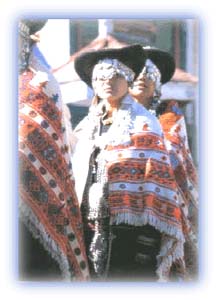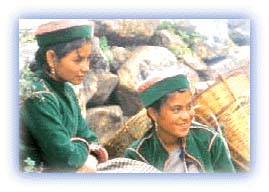Kinnaur himalayas
General Info
· The Satluj Saga
· The Story of the Baspa
· Valleys
· Hangrang valley
· Ropa valley
· Bhaba valley
· Other places of interest
· Nilchar
· Kalpa and Peo
· Pooh
· Moorang
Climate and Vegetation
People
· Traditions and Culture
· Livelihood
· Villages in Kinnaur
Religion
· Hinduism
· Buddhism
· Superstitions and Beliefs
Fairs and Festivals
Art and architecture
History

![]()
| Kinners or Kinnauras The people of Kinnaur in Himachal Pradesh have traditionally been referred to as Kinners. The term Kinnauras is also widely used. They live under very harsh conditions, created by the inclement weather and climatic conditions. |
The legend of the Sangla valley, Kinnaur. (Download Realplayer) |
 |
| Kinners during festivities. Credit: Discover India |
The People of the Indian state of Himachal Pradesh, particularly the tribes, were left alone during the British rule in India, but after India's independence, changes took place due to improvements in communications and the establishment of post offices and banks etc. Modernization is slowly influencing their hill culture, their traditions and their way of life. Due to the spread of education and widespread contact with outsiders, the educated Himachalis have started to break away from their age-old traditions.
The hill people are frank, honest, hospitable and peace loving. The life of the people is simple and hard. However, they have a rich cultural legacy and a wealth of legends and myths. The standard of literacy in the region was low till the 1980s, but in recent times the government has made every effort to increase educational facilities and introduced compulsory primary education, due to which the literacy rate has increased considerably.
The results of old contacts with Tibet are still visible in the fairs and festivals and other customs of the people in the remote areas. It is interesting to note, however, that the customs have undergone a change. With the increase in the number of visitors from the plains, the younger generations are rapidly taking to modern ideas and adapting to changes.
 |
| Kinner girls. Credit: Discover India |
The women of Kinnaur are famous for their beauty and there are many references to it in books of olden times. According to the old scriptures, the Kinner Kanyas (girls) were famous for their beauty and were used as Vish Kanyas (poison girls) by the kings and royal families to overcome their enemies through their seductive "talents".
All rights reserved